On Using Ilities of Non-Functional Properties for Subsystems and Components
Abstract
:1. Introduction
- We explore the emergence characteristics of ilities in Section 2.
- We develop an ilities application method for subsystems in Section 3. We leverage the prior works on the Systems of Systems Architecting with Ilities (SAI) method to achieve this goal.
- We show examples for how ilities of complex systems are flowed down to subsystems or components in Section 4. The point of this section is to establish the legitimacy of the premise.
- We explore the ilities usages in the context of system architecture principles and present the dual functional nature of ilities in Section 5.
2. Characterization and Scope of Ilities in Systems Engineering
3. Ilities Application at the Subsystem Level
- Step 1: In the first step, overall values and constraints are called out for systems and subsystems. Value proposition is identified and captured for their architecture. Key stakeholders are engaged and their needs and design constraints are noted. An example of value proposition at a system and subsystem levels for aircraft is found in the Federal Aviation Administration (FAA) value statement about safe transportation for the general public.
- Step 2: Potential perturbations and risk for subsystems are investigated and identified for both the systems development phase and for the service engineering (post-delivery) phase. Potential perturbations in the system needs lead to subsystem design, and those identified post-delivery lead to maintenance and repair of the subsystems. One example of dynamic and uncertain environmental perturbations is the electromagnetic and lightning effects on aircraft systems, subsystems and components. Perturbations and risk are also emergent properties of systems or subsystems.
- Step 3: Initial desired ilities are studied: list ilities that promote the desired long-term behavior of the subsystems. An examination of relevant perturbations in step 2 could generate possible desired ilities. An example of initial desired ilities in aircraft may include safety, quality, reliability or maintainability.
- Step 4: Subsystem architecture alternatives are set up: the purpose of this step is to suggest various architectures for the value proposed in step 1. These alternatives comprise a set of architecture solutions. An example of architecture alternatives in aircraft may include design options for electromagnetic interference (EMI) hardening.
- Step 5: Ility-driving options are produced: this step enables the investigation of the solution space in step 4, and provides initial architectures that promote the long-term values of the desired ilities. An example of solution space in our context could include grounding, shielding and bonding options at various levels.
- Step 6: Alternative architectures are evaluated for their values, and analyzed with models. The final product of this step is the selected subsystem architecture, which manifest the desired ilities over the lifecycle by pre-delivery development or post-delivery repair and maintenance.
4. Ilities Application Example in an Aircraft Environment
- Step 1: In the commercial aviation domain, safe transportation is known to be a key system or subsystem level value by stakeholders such as the FAA, the European Aviation Safety Agency (EASA), aircraft manufacturers, and airliners. Furthermore, the governmental agencies provide constrains in the form of Federal Aviation Regulations (FAR) and other rules. We note that safe transportation is the primary value in aircraft operation, as the following mission and value statements of the FAA attests [28]:“Our continuing mission is to provide the safest, most efficient aerospace system in the world. Safety is our passion. We work so all air and space travelers arrive safely at their destinations.”This statement corresponds to the value proposition in step 1 of the previous section, and is a major motivating factor for every policy and regulation decision made by the FAA. This emphasis on safety is also shared by the manufacturers of commercial airliners. For instance, the vision statement of Boeing emphasizes [29]:“We value human life and health above all else and take action accordingly to maintain the safety of our workplaces, products and services.”Airliners also understand that the future of their company depends upon producing products that maintain the safety of their transportation. Based on these considerations, transportation with safety is introduced to aviation industry as one of the most critical values that cover the system level needs. The value proposition of safe transportation should be flowed down to subsystems, and subsystem level requirements should be considered to protect aircraft from environmental threats [30]. Safe transportation is a value proposition from stakeholders based on their needs and it is an emergent property of aircraft as a system.
- Step 2: Potential perturbations are identified. As an example, let’s analyze the electromagnetic and lightning perturbations. Consider how safety is applied with respect to electromagnetic environmental threats on aircraft. Aircraft subsystem engineers apply a context diagram for environmental threat categories, such as the one shown in Figure 3. It describes the uncertain and dynamic electromagnetic perturbations of aircraft such as lightning, high-intensity radiated fields (HIRF), portable electronic devices (PEDs), precipitation static (P-static), and electromagnetic interference and compatibility (EMI/EMC) [31,32]:Lightning: These are lighting strikes on the aircraft body during flight or while on the ground [33].HIRF: These are high-intensity radiated fields from sources such as airport radars, radio transmitting towers, to name a few.PEDs: These are portable electronic devices such as mobile phones, lap tops, and tablets which can radiate electromagnetic energy when taken onboard an aircraft [34,35].P-Static: This is precipitation static caused by friction between air particles and the surface of aircraft while the aircraft is flying.
- Step 3: We identify safety as the desired ility. Electromagnetic (EM) and lightning effects are an example of environmental perturbation with negative implications. EM and lightning effects are directly related to the safety ility of aircraft system. Safety ility is absorbed by the subsystem experts and used as a guide for decisions, specifications, and processes. Subsystem engineers consider the targets of these electromagnetic threats in aircraft, as shown in Figure 4, and translate the system level safety concerns into subsystem or component level requirements. Translation requires specific knowledge of the subsystems that are affected by EM threats. Specifically, we may consider the fuel tank and the possibility of fuel tank explosion due to lightning strikes. Safety as an emergent ility at the aircraft level is flowed down to the fuel tank subsystem, and is translated into the specific subsystem requirement, such as the probability requirement of fuel tank explosion. This process of flow downwards occurs when the subsystem and component experts develop testing methods, requirements, and qualification processes.
- Step 4: Several development or maintenance alternatives of subsystem modules are proposed from the standpoint of decreasing vulnerability to electromagnetic and lightning threats.
- Step 5: Ility-driving options are generated. At the subsystem level, these options are generated from risk mitigation and resolution activities. Electromagnetic and lightning perturbation mitigation are performed based on the flow diagram in Figure 5. Examples of the lightning-related perturbation are shown below [33]. The three example situations are for (1) direct lightning effect, (2) indirect lightning effect, and (3) the fuel tank.
- (1)
- Direct lightning effect perturbations at the subsystem and component levels may occur as follows:
- Melt-through damage for metal or non-metal skins (of fuel tank skin, trailing edge, painted skin, and radome).
- Resistive heating damage (bonding strap heating or exploding wires for a navigation light on a plastic vertical fin cap, diverter straps, pitot probe air tube, and radome) or magnetic force effects (slamming together of two metal air pressure tubes in a radome mounted pitot system, in wing-tip trailing edges, bent bond straps).
- Arcing across bonds (over riveted joints with corrosion inhibiting coating, over fasteners or bonding jumpers with inadequate current carrying capacity, over fasteners in secondary structures such as wing tips, tail cones, wheel well doors, and flight control surfaces, over adhesive bonds, over hinges and bearings resulting in pitting or welding).
- Sparking over structural joints.
- Punctures or flashover over non-conductive composite material (radomes, composite material skin).
- Damage of windshields, canopies, windows (direct or swept channel attachment to heating elements and damaging the connected power circuits).
- Damages on electrically conductive composites (carbon fiber composite skins in Zone 1 and 2 by lightning stroke currents via mechanisms of pyrolysis and shock wave; primary structures, engine nacelle and pylon, flight control surface, leading edge devices, avionics bay, wing and empennage tips, fuel tank skin).
- Damage of propulsion system (engine cowlings or nacelles, propeller and rotor blades, gear boxes damaged by lightning attachments).
- Rain erosion of conductive lightning protection strip (degradation of conductive frame on wings and empennage).
- (2)
- Lightning indirect effect perturbations may occur at the following subsystems:
- Full authority digital engine control (FADEC).
- Full authority electronic flight control (Fly-by-wire).
- Supervisory control systems capable of initiating control inputs that could endanger flight safety.
- Fully or highly-integrated cockpit instruments and displays.
- Electronic flight instrumentation system (EFIS).
- Aircraft electric power control and distribution system.
- Electrical and avionics systems that include externally mounted apparatus, such as air data probes, heaters, actuators, and antennas.
- (3)
- Lightning strike perturbations such as fuel tank subsystem ignition or fire.
- Step 6: The solution space developed from the previous steps is evaluated, analyzed and the optimum solutions are selected and documented.
5. Principles of System Architecture, Dualism, and Dual Nature of Ilities
6. Ilities Application in the Context of Systems Architecture Engineering
7. Summary and Conclusions
Author Contributions
Conflicts of Interest
References
- International Council on Systems Engineering (INCOSE). Systems Engineering Handbook; John Wiley & Sons: Hoboken, NJ, USA, 2015. [Google Scholar]
- De Weck, O.L.; Roos, D.; Magee, C.L. Engineering Systems; The MIT Press: Cambridge, MA, USA, 2011; p. 66. [Google Scholar]
- Corpino, S.; Nichele, F. An ilities-driven methodology for the analysis of gaps of stakeholders needs in space systems conceptual design. IEEE Syst. J. 2016, 1–10. [Google Scholar] [CrossRef]
- Wilmot, J.; Fesq, L.; Dvorak, D. Quality attributes for mission flight software: A reference for architects. In Proceedings of the IEEE Aerospace Conference, Big Sky, MT, USA, 5–12 March 2016. [Google Scholar]
- De Weck, O.L.; Ross, A.M.; Rhodes, D.H. Investigating relationships and semantic sets amongst system lifecycle properties (ilities). In Proceedings of the 3rd International Conference on Engineering Systems, TU Delft, The Netherlands, 18–20 June 2012. [Google Scholar]
- De Weck, O.L.; Jones, M.B. Isoperformance: Analysis and design of complex systems with desired outcomes. Syst. Eng. 2006, 9, 45–61. [Google Scholar] [CrossRef]
- McManus, H.L.; Richards, M.G.; Ross, A.M.; Hastings, D.E. A Framework for Incorporating “ilities” in Tradespace Studies. In Proceedings of the AIAA Space 2007, Long Beach, CA, USA, 18–20 September 2007. [Google Scholar]
- McManus, H.L.; Hastings, D.E. A Framework for understanding uncertainty and its mitigation and exploitation in complex system. IEEE Eng. Manag. Rev. 2006, 34, 81–94. [Google Scholar] [CrossRef]
- Fricke, E.; Schulz, A.P. Design for changeability (DfC): Principles to enable changes in systems throughout their entire lifecycle. Syst. Eng. 2005, 8, 342–359. [Google Scholar] [CrossRef]
- Butterfield, M.L.; Pearlman, J.S.; Vickroy, S.C. A system-of-systems engineering GEOSS: Architectural approach. Syst. J. IEEE 2008, 2, 321–332. [Google Scholar] [CrossRef]
- Viscito, L.; Ross, A.M. Combining pareto trace and filtered outdegree as a metric for identifying valuably flexible designs. In Proceedings of the 7th Conference on Systems Engineering Research, Loughborough, UK, 20–23 April 2009. [Google Scholar]
- Ross, A.M.; Rhodes, D.H.; Hastings, D.E. Defining Changeability: Reconciling flexibility, adaptability, scalability, modifiability, and robustness for maintaining lifecycle value. Syst. Eng. 2008, 11, 246–262. [Google Scholar] [CrossRef]
- Aristotle. Metaphysics; Penguin Classics: London, UK, 1999. [Google Scholar]
- Johnson, C.W. What are emergent properties and how do they affect the engineering of complex systems? Reliab. Eng. Syst. Saf. 2006, 91, 1475–1481. [Google Scholar] [CrossRef]
- Bedau, M. Downward causation and the autonomy of weak emergence. Principia 2002, 6, 5–50. [Google Scholar]
- Deguet, Y.; Demazeau, L. Magnin Elements about the emergence issue: A survey of emergence definitions. Complexus 2006, 3, 24–31. [Google Scholar] [CrossRef]
- Gore, R.; Reynolds, P.F., Jr. An exploration-based taxonomy for emergent behavior analysis in simulations. In Proceedings of the Winter Simulation Conference, Washington, DC, USA, 9–12 December 2007. [Google Scholar]
- Szabo, C.; Teo, Y.M.; Chengleput, G.K. Understanding complex systems: Using interaction as a measure of emergence. In Proceedings of the Winter Simulation Conference, Savanah, GA, USA, 7–10 December 2014. [Google Scholar]
- Crutchfield, J. Is anything ever new? Considering emergence. In Santa Fe Institute Working Paper; Addison-Wesley: Boston, MA, USA, 1994. [Google Scholar]
- Corning, P.A. The re-emergence of emergence: A venerable concept in search of a theory. Complexity 2002, 7, 18–30. [Google Scholar]
- Crawley, E.; Cameron, B.; Selva, D. System Architecture: Strategy and Product Development for Complex. Systems; Pearson Education: Upper Saddle River, NJ, USA, 2016; inside of the front cover. [Google Scholar]
- Crawley, E.; Cameron, B.; Selva, D. System Architecture: Strategy and Product Development for Complex. Systems; Pearson Education: Upper Saddle River, NJ, USA, 2016; p. 11. [Google Scholar]
- Blanchard, B.S.; Fabrycky, W.J. Systems Engineering and Analysis; Prentice Hall: Upper Saddle River, NJ, USA, 2011; pp. 5–6. [Google Scholar]
- Ricci, N.; Fitzgerald, M.E.; Ross, A.M.; Rhodes, D.H. Architecting systems of systems with ilities: An overview of the SAI method. Procedia Comput. Sci. 2014, 28, 322–331. [Google Scholar] [CrossRef]
- Lee, J.Y.; Collins, G.J. Risk analysis of electromagnetic effects in aircraft. In Proceedings of the IEEE Aerospace Conference, Big Sky, MT, USA, 4–11 March 2017. [Google Scholar]
- Lee, J.Y.; Collins, G.J. Risk analysis of lightning effects in aircraft system. In Proceedings of the IEEE Aerospace Conference, Big Sky, MT, USA, 4–11 March 2017. [Google Scholar]
- Genender, E.; Garbe, H.; Sabath, F. Probabilistic risk analysis technique of intentional electromagnetic interference at system level. IEEE Trans. Electromagn. Compat. 2014, 56, 200–207. [Google Scholar] [CrossRef]
- Federal Aviation Administration. FAA Mission. Available online: https://www.faa.gov/about/mission/ (accessed on 10 April 2017).
- Boeing. A Foundation of Innovation. Available online: http://www.boeing.com/principles/vision.page (accessed on 10 April 2017).
- Moir, I.; Seabridge, A. Aircraft Systems Mechanical, Electrical and Avionics Subsystems Integration; John Wiley & Sons: West Sussex, UK, 2008. [Google Scholar]
- Paul, C.R. Introduction to Electromagnetic Compatibility; John Wiley & Sons: Hoboken, NJ, USA, 2006. [Google Scholar]
- Ott, H. Electromagnetic Compatibility Engineering; John Wiley & Sons: Hoboken, NJ, USA, 2009. [Google Scholar]
- Fisher, F.A.; Plumer, J.A.; Perala, R.A. Lightning Protection of Aircraft; Lightning Technologies: Pittsfield, MA, USA, 2004. [Google Scholar]
- Ely, J.J. Electromagnetic Interference to Flight Navigation and Communication Systems: New Strategies in the Age of Wireless. In Proceedings of the AIAA Guidance, Navigation, and Control. Conference and Exhibit, San Francisco, CA, USA, 15–18 August 2005. [Google Scholar]
- Federal Aviation Administration (FAA). Advisory Circular (AC) 91.21-1C, Use of Portable Electronic Devises Aboard Aircraft; Federal Aviation Administration: Washington, DC, USA, 2015. [Google Scholar]
- Borky, J.M. Architecting Information-Intensive Aerospace Systems, Unpublished.
- Blanchard, B.S.; Fabrycky, W.J. Systems Engineering and Analysis, 5th ed.; Prentice Hall: Upper Saddle Riverm, NJ, USA, 2011; pp. 33–35. [Google Scholar]
- Kossiakoff, A.; Sweet, W.N.; Seymour, S.J.; Biemer, S.M. Systems Engineering Principles and Practice; John Wiley & Sons: Hoboken, NJ, USA, 2011; pp. 69–106. [Google Scholar]
- Ferreira, S.; Faezipour, M.; Corley, H.W. Defining and addressing the risk of undesirable emergent properties. In Proceedings of the IEEE International Systems Conference (SysCon), Orlando, FL, USA, 15–18 April 2013. [Google Scholar]
- Black, J.; Koopman, P. System safety as an emergent property in composite system. In Proceedings of the International Conference on Dependable Systems and Networks, Lisbon, Portugal, 29 June–2 July 2009. [Google Scholar]
- Vinerbi, A.; Bondavallli, A.; Liollini, P. Emergence: A new source of failures in complex systems. In Proceedings of the IEEE The Third International Conference on Dependability (DEPEND), Venice, Italy, 18–25 July 2010. [Google Scholar]
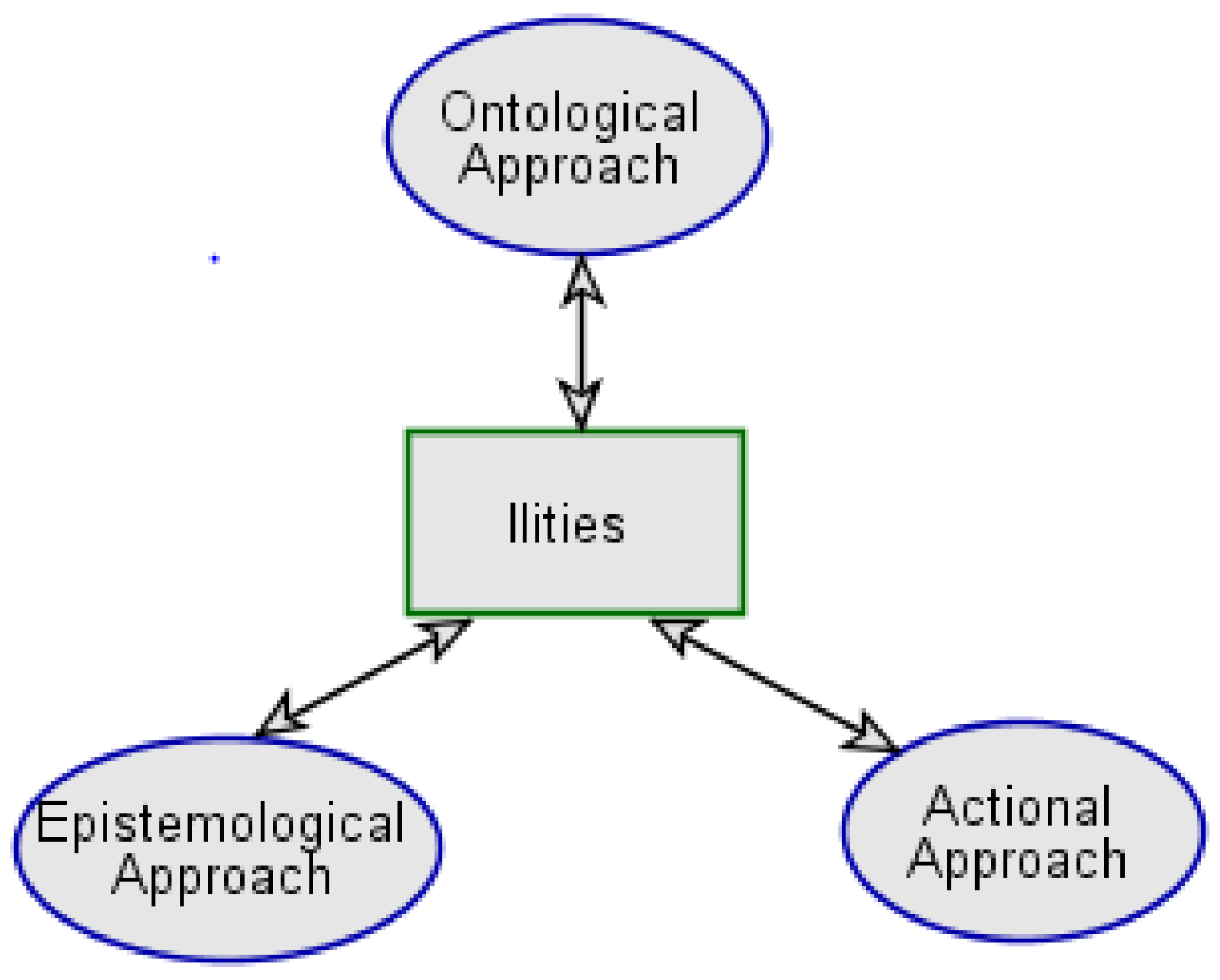
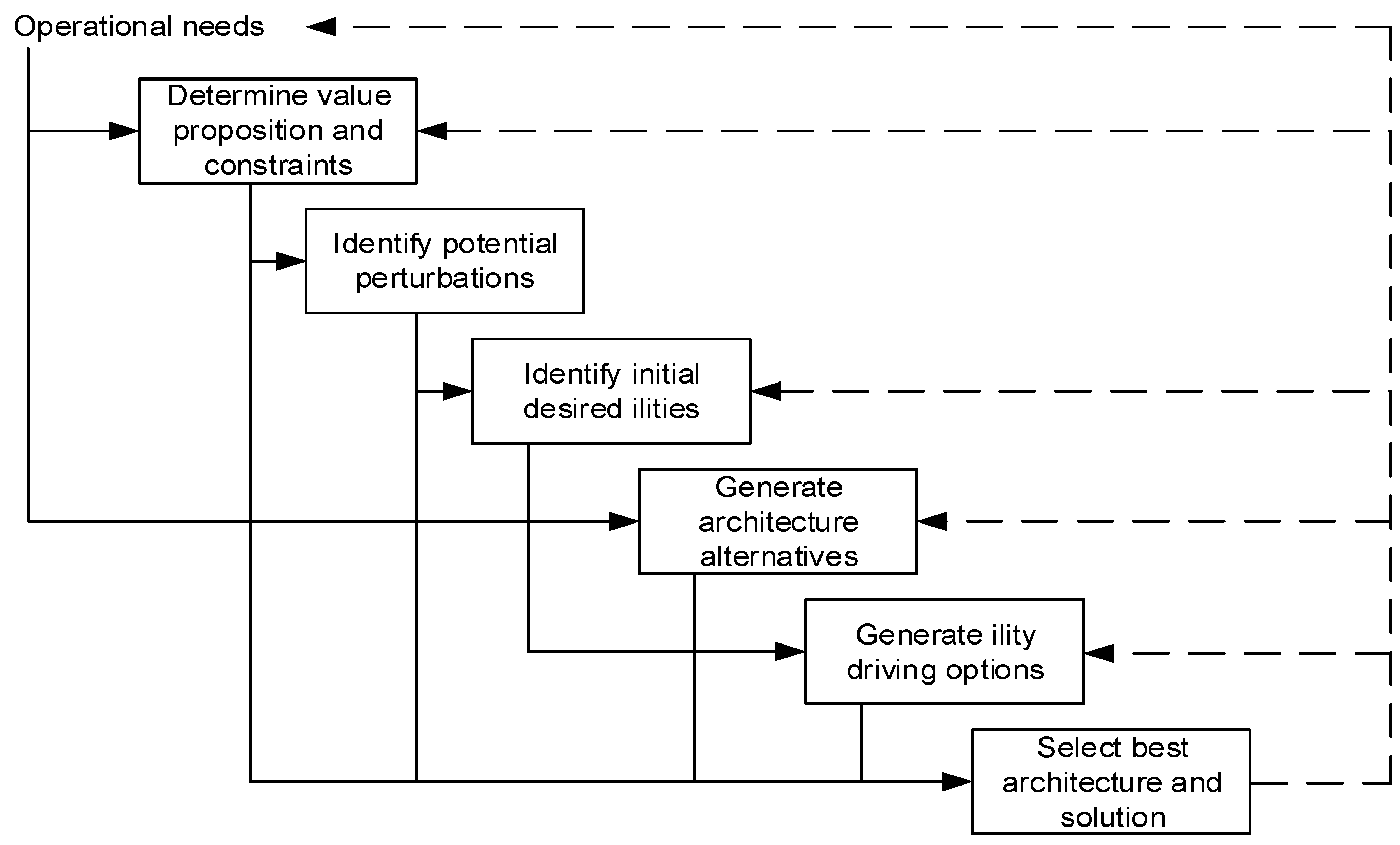
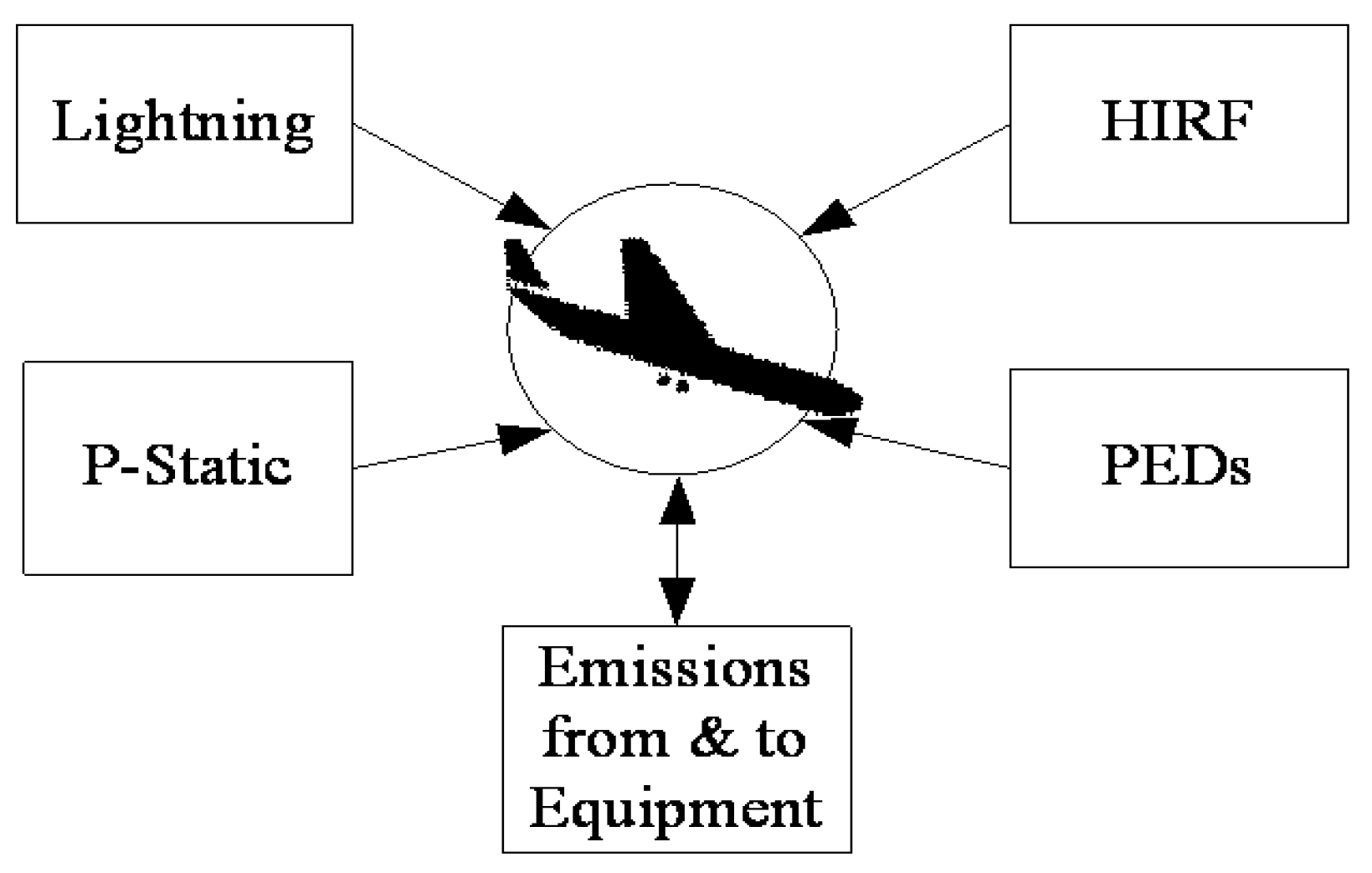
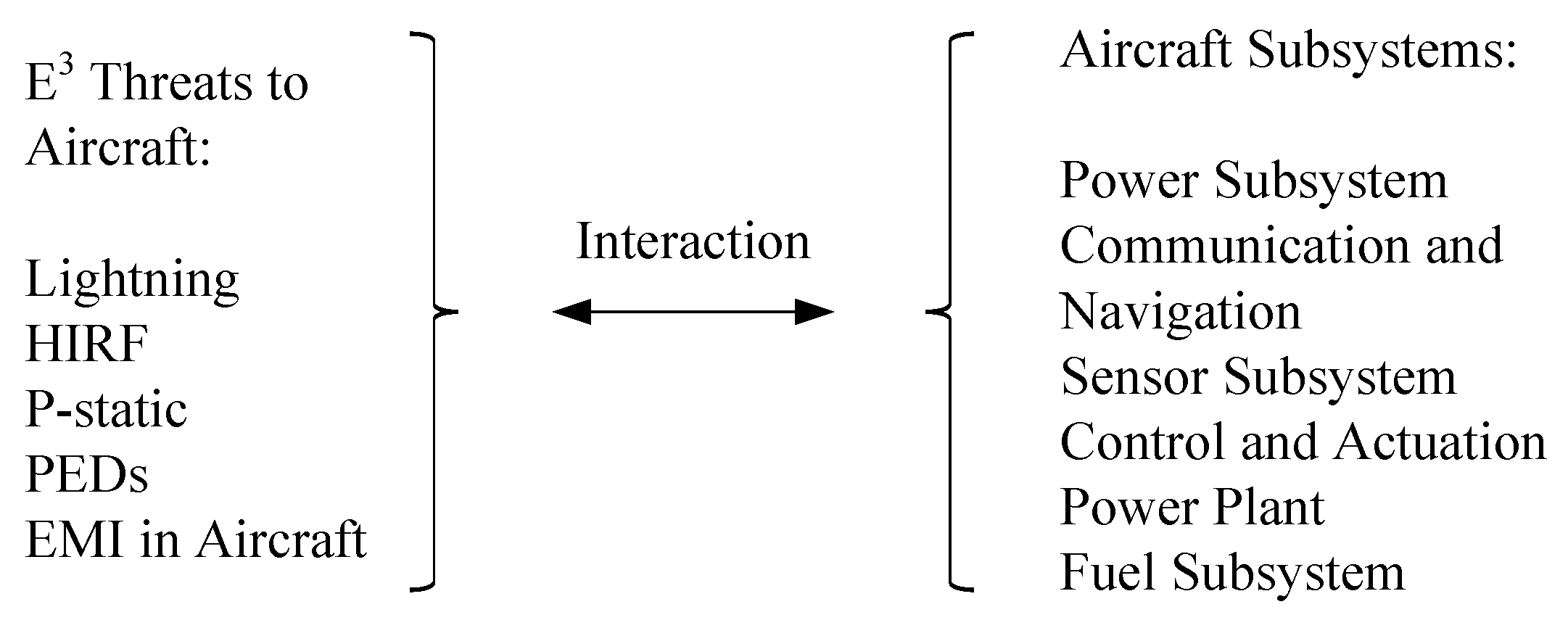


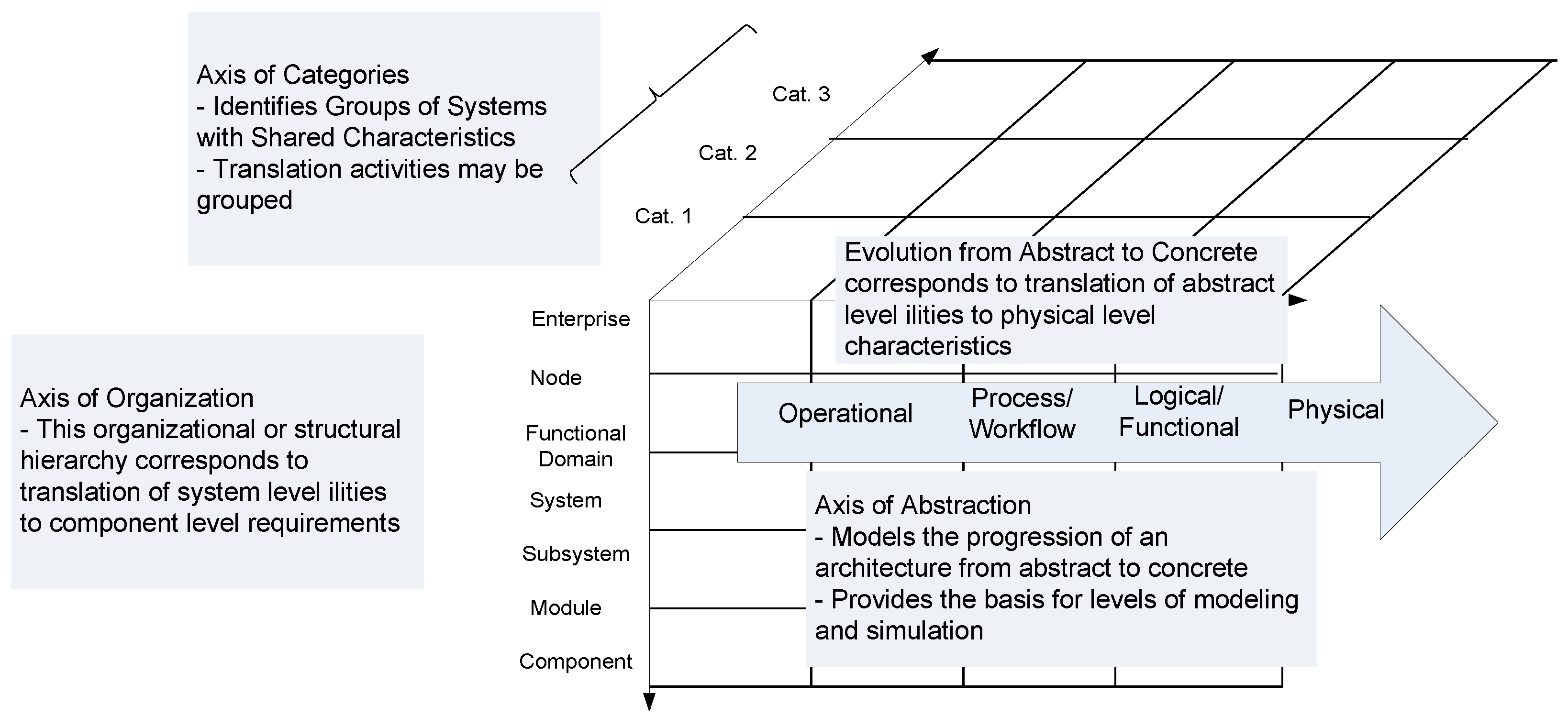
| Ility | Value | Lights |
|---|---|---|
| Safety | Certification | 8 lights |
| Quality | Customer needs | 12 lights |
| Reliability | Reliable light subsystem | No defect and long lasting |
| Maintainability | Airplane maintenance | Easily maintainable lights |
| System Ility | Subsystem Ility | Subsystem (Category) | Subsystem Parameters |
|---|---|---|---|
| Safety | Safety | Fuselage (DLE) | Melt-through damage |
| Safety | Safety | Navigation Light /Pitot tube (DLE) | Resistive heating damage |
| Safety | Safety | Wing tip/Tail cone (DLE) | Arcing across bonds |
| Safety | Safety | Structural joints (DLE) | Sparking |
| Safety | Safety | Radome (DLE) | Puncture |
| Safety | Safety | Windshield, canopy, window (DLE) | Mechanical damage |
| Safety | Safety | Composite (DLE) | Damage |
| Safety | Safety | Propulsion system (DLE) | Mechanical and thermal damage |
| Safety | Safety | Conductive strip on rudder (DLE) | Rain erosion |
| Safety | Safety | Full authority digital engine control (DLE) | Anomaly in engine control |
| Safety | Safety | Full authority electronic flight control (DLE) | Flight control error |
| Safety | Safety | Supervisory control systems (DLE) | Erroneous control |
| Susceptibility | Susceptibility | Fully or highly integrated cockpit instruments and displays (ILE) | Flickering in display |
| Susceptibility | Susceptibility | Electronic flight instrumentation system (ILE) | Error with instrumentation |
| Susceptibility | Susceptibility | Aircraft electric power control and distribution system (ILE) | Unpredictable Power shedding |
| Susceptibility | Susceptibility | Electrical and avionic systems (ILE) | Air data malfunction |
| Safety | Safety | Fuel Tank (FTI) | Tank Flammability |
| Principle | Explanation | |
|---|---|---|
| 1 | Emergence | As a system is formed by putting elements together, due to interaction between elements, function, performance, ilities and emergencies emerge |
| 2 | Holism | Every system is a part of a larger system, and is a system of smaller systems |
| 3 | Focus | The number of identifiable issues of a system at any point is beyond one‘s ability to understand. Identify and focus on the most critical issues |
| 4 | Dualism | All built systems exist in the physical domain as well as in the informational domain |
| 5 | Coherence | The physical system and the conceptual system should be coherent with each other |
© 2017 by the authors. Licensee MDPI, Basel, Switzerland. This article is an open access article distributed under the terms and conditions of the Creative Commons Attribution (CC BY) license (http://creativecommons.org/licenses/by/4.0/).
Share and Cite
Lee, J.Y.; Collins, G.J. On Using Ilities of Non-Functional Properties for Subsystems and Components. Systems 2017, 5, 47. https://doi.org/10.3390/systems5030047
Lee JY, Collins GJ. On Using Ilities of Non-Functional Properties for Subsystems and Components. Systems. 2017; 5(3):47. https://doi.org/10.3390/systems5030047
Chicago/Turabian StyleLee, James Y., and George J. Collins. 2017. "On Using Ilities of Non-Functional Properties for Subsystems and Components" Systems 5, no. 3: 47. https://doi.org/10.3390/systems5030047
APA StyleLee, J. Y., & Collins, G. J. (2017). On Using Ilities of Non-Functional Properties for Subsystems and Components. Systems, 5(3), 47. https://doi.org/10.3390/systems5030047




